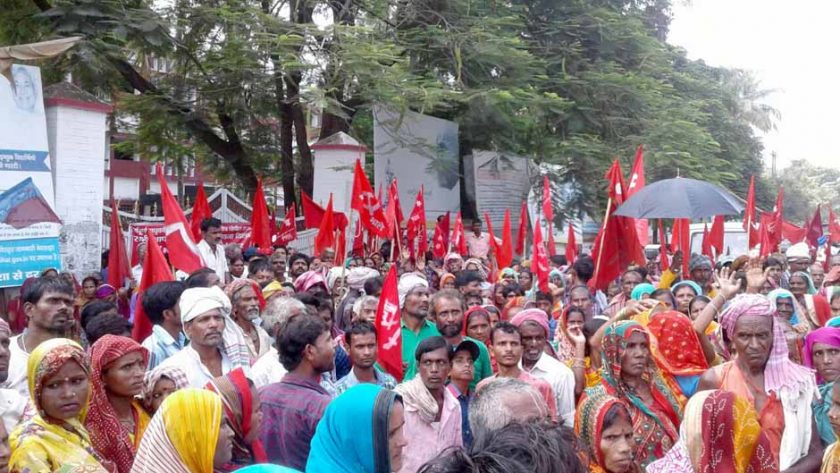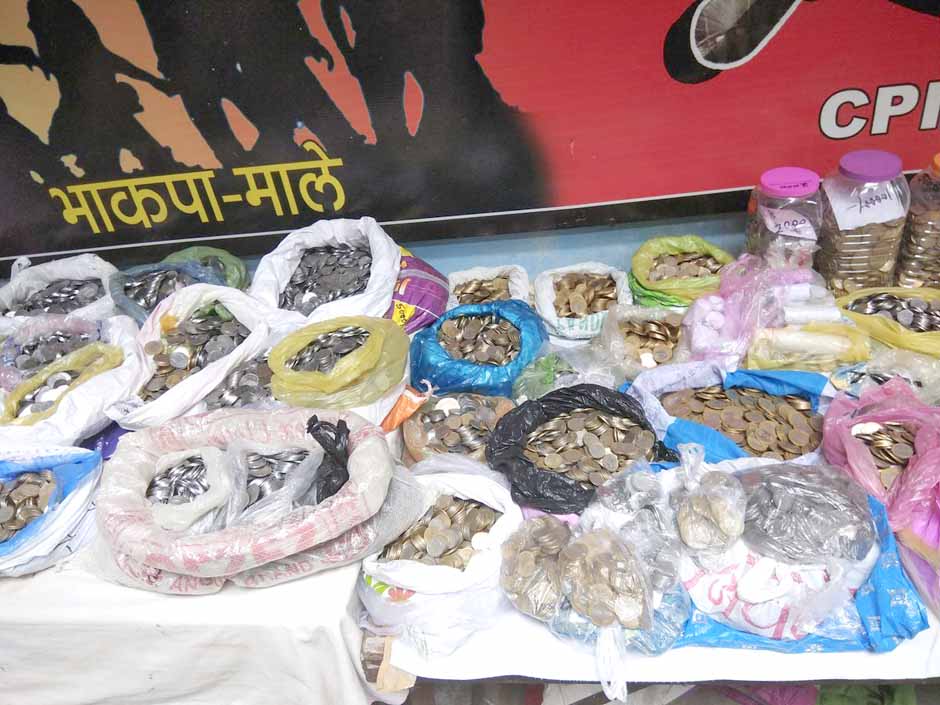
[A CPI(ML) report on the Bihar flood relief situation.]
Half the population of Bihar is affected by the floods. The regions of Seemanchal and Champaran have been especially devastated by the floods. The floods’ devastating power was enhanced manifold by the lack of preparation on part of the State Government made no preparations prior to the floods. Now that the flood waters have started receding, the extent of devastation caused is gradually becoming clear.
Those affected by the flood are in need of urgent relief work however, the reports that are being received from the districts regarding relief work are highly unsatisfactory. Not only is the speed of the relief work extremely slow, the state government has imposed several kinds of conditions for providing relief packages. As a result, a significant population of those affected by the floods will not be able to benefit from the flood relief campaigns of the state. The intentions of the state government do not seem to be aimed towards providing relief to all.
Mandatory Aadhaar and Other Irrational Conditions For Relief
The worst affected by floods are always the poor. The pukka buildings often manage to survive the rapid speed of the flooding waters; however, it is the huts and dwellings of the poor that are worse hit. It is largely the agricultural labourers, rural labourers and poor farmers who live in these huts. The governments never do an estimation of these dwellings that are destroyed during the floods.
There is also significant loss of the cattle or livestock during these floods. A report from the Narpatgunj area in Araria reveals that nearly one thousand livestock got swept away in the floods. The question of crops getting destroyed is also an essential one. If all of these are added up, then we will realise that the damage estimates being presented by the government are significantly lower than the actual damages. Consequently, since the government is doing a low estimation of the loss, the relief campaign is also extremely weak. The disaster management campaign of the Bihar government has proved to be a failure right from preventing floods to providing relief work.
In Champaran, as the water levels began to recede, the problem of starvation made its appearance. Instead of providing immediate money to the affected, the government is talking about sending the money to their bank accounts. For this, those affected by the floods are required to fill a relief form. The money will be sent to the account only after matching the form with Aadhaar Card and bank account. It is well known that there are several poor who do not have bank accounts or Aadhaar cards: where does the government expect them to get papers from after losing their homes in floods? Such conditions rub salt into the wounds of the flood affected people.
The Bihar State Standing Committee member of CPI (ML), Comrade Virendra Prasad Gupta has shared several instances that highlight the administrative neglect during the relief work. He found that in the Badkagaon Nayaka Tola of North Ghoga Panchayat in Chanpatiya block in West Champaran, food grains packets are being prepared that weigh only 5 kilograms each and have not still been distributed. On the other hand, the list that has been prepared of people who have been affected by floods, is based on a 2011 census. Since then, several new families have come and established themselves in these areas – these have been excluded from these lists. He gives the example from ward no. 7 of this village where 35 families have been kept out of the list. There is nothing left in their homes and the families are on the verge of starvation.
The administration has also said that only those people will be considered affected by floods in whose homes the water stayed for 72 hours or more. This is being said in times when the speed of the flooding waters was such that nearly everything got destroyed within a matter of 5-6 hours. Harpur village in Gaunaha block was surrounded by floods from all sides. The government did nothing to rescue people stuck in the floods. People from the nearby village of Pipra use to somehow cross the canal to provide food to the villagers of Harpur. Akash drowned while taking food for the people of Harpur village. Since his body was not recovered, the administration is refusing compensation to his family.
In Sikta block, it was only after the water began to recede near Gopalpur thana that people started coming and going. People are trying to find their relatives and family members; however despite several requests, the administration has not provided them with a single boat. Till now, the amount of Rs.6000, has not been received in any account. Discrimination is also being practiced during the preparation of the list for destruction of crops. Everyone knows that nearly 80% of the agriculture in Bihar is done by sharecroppers, however they are not being included in the list.
Plight Of The Displaced
 The situation of flood relief is similar in Darbhanga. Three tolas have been completely filled with mud after the breaking down of Kamla embankment. However, in the name of the relief work, only chura (rice flakes) and plastic sheets for shelter have been distributed in a few places. While a few camps have been set up up in schools, a huge part of the population is still sleeping on higher places or on roads under the sky. They have not yet been provided with drinking water, let alone shelters. In one of the panchayats in Hanumannagar block, the administration sent only 20 plastic bags! The people in Hanumannagar block that has about 14 panchayats, became angry when only 280 plastic bags were sent for distribution. They refused to accept the plastic. About 3000 families who have been affected by the floods are being forced to survive on roads. In several other places too, no relief work has reached yet.
The situation of flood relief is similar in Darbhanga. Three tolas have been completely filled with mud after the breaking down of Kamla embankment. However, in the name of the relief work, only chura (rice flakes) and plastic sheets for shelter have been distributed in a few places. While a few camps have been set up up in schools, a huge part of the population is still sleeping on higher places or on roads under the sky. They have not yet been provided with drinking water, let alone shelters. In one of the panchayats in Hanumannagar block, the administration sent only 20 plastic bags! The people in Hanumannagar block that has about 14 panchayats, became angry when only 280 plastic bags were sent for distribution. They refused to accept the plastic. About 3000 families who have been affected by the floods are being forced to survive on roads. In several other places too, no relief work has reached yet.
The situation in Muzaffarpur is also similar. The floods caused massive destruction in the Bhutane panchayat in Bochhan block. From farms to crops, everything was destroyed and yet the relief work is extremely slow. Nearly 2000 families have been affected. However, the government has sent only 500 packets. The entire population of Majhauli, Devgan, Karnpur and other panchayats have been affected by the calamity. However, in these panchayats also, merely 500 packets have been sent. In the premises of Musahari block, a relief camp has been opened for demonstration purpose, however, the government has made no arrangements for the thousands of people stuck in villages. At the dam itself, nearly 8000 families have been forced to live the lives of the displaced! This is the situation in Bethakpur, Barauli, Dumri and several other panchayats.
The maximum impact of the floods has been in the Seemanchal region. Nearly 80% area of Araria is in the grip of the floods. There is an outcry all around. However, under the pretext of Aadhaar Card, the district administration is denying aid to the needy. Rice packets weighing 5 kilos are being distributed but they have not reached in nearly 80% of the affected areas. Rs.6000 have also not been received in any account. Dinesh Rishidev, Deepnarayan Rishidev, Dhirendra Rishidev and others of Barbana village in Raniganj shared that the administration has been telling them that since the flood waters did not reach the courtyard, it will not be considered flood. All people from Rahariya village have been displaced and brought to roads. On this basis, the administration has denied the relief to the entire village.
Barahchowk, Muraripur and other areas in Sikti block are also in the grip of the floods. However, here the administration is saying that since the flood waters did not reach the stove, they cannot be considered flood affected regions. It is clear that a significant population of Seemanchal comprises of the Dalit poor and minorities and hence the attempts to exclude them from relief. Several regions of Katihar are completely hit by the floods. The plight of the relief campaign is such that in Barsoi block, mere 200 quintals of rice were provided, which is a like a mere drop in the ocean.
A few monitoring camps were put up, some of which functioned for one day, some for two. There are 31 panchayats in the Barsoi block, 90% of which are in the grip of floods, however, the government provided only about 7 boats. In several areas like Dharmpur, Malsar, Karnpur, Belvadangi, Basalgaon, Chaandtara, not even a single grain of relief materials has reached. The government had assured that by Bakr-Id all the needy will be provided food packets and Rs.6000. However, the Bakr-Id is gone now and no one has received money in their account.
Protests By Flood-Affected People
Flood-affected people, organised by CPI(ML), protested since Day One against the criminal negligence before and during the floods and also against the gross apathy towards the flood affected that followed. On one hand, pressure is being built on the administration through continuous protests, on the other hand, a relief campaign is also being organised.
A notable feature of the CPI(ML) fund collection campaign was the fact that the poorest and most deprived people contributed their mite – in coins; as a result, the bulk of the amount collected was in bagfuls of coins.
Protesters are demanding that the flood hit people be provided with 2 quintals ration and Rs.10,000 cash; Sharecroppers and other farmers whose livelihoods have been destroyed should be provided compensation at Rs.20,000 per acre and their electricity bills and agricultural loans be waived; the discrimination in preparation of lists for relief work should be ended; Rs.20,000 should be given to those whose houses were destroyed in floods along and they should be provided with pakka homes and urgent provision of plastic. It was also demanded that to provide employment, MNREGA work and sand mining work should be continued. Medicines and presence of doctors was demanded in the health centres and subcentres. It is clear that all of these are absent in the relief being provided by the government. The intention of the government is clear- to somehow shorten the list of those who need relief, impose all kinds of conditions and fulfil a formality. The need however, is to organise the extensive relief work on a massive scale, without imposing any conditions. Along with relief camps, even rehabilitation of those displaced appears to be nowhere in the agenda of the government. When the government cannot provide urgent relief, what else can be expected of it.
